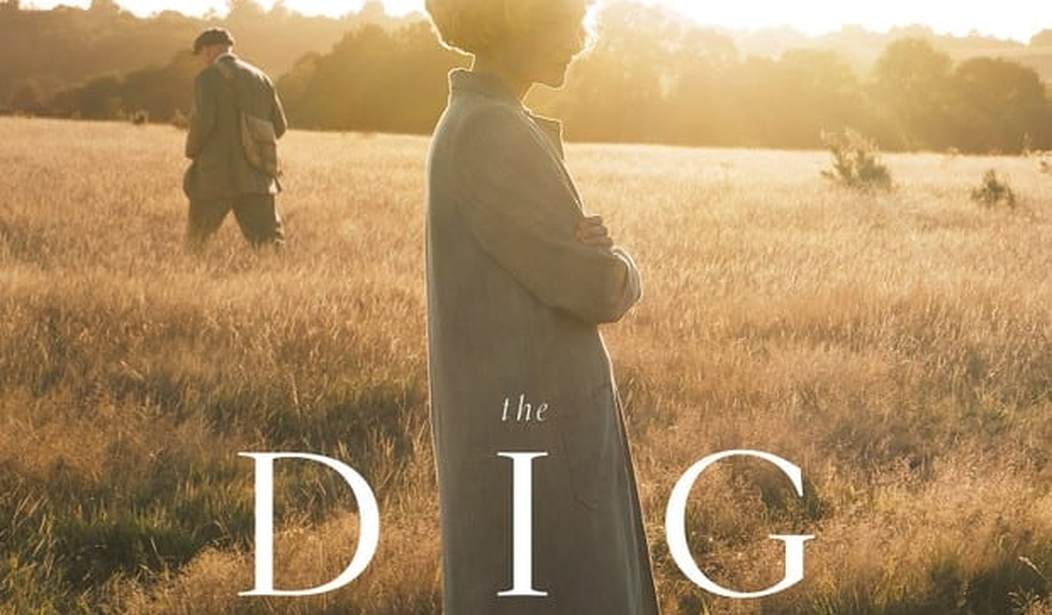Netflix’s The Dig is an unusual film. Its telling of a true 20th century story is deliberately slow-paced, with a sense of foreboding despite the fact that its two central characters demonstrate remarkable character and succeed in their goal.
That goal is to find out just what is as the bottom of a strange mound on land owned by widow Edith Pretty. It’s just curiosity, plus a feeling that the mound is not natural and might have a story to tell.
Pretty (Carey Mulligan) hires amateur archaeologist Basil Brown (Ralph Fiennes) to excavate. At first he believes the mound might be a Viking burial, but speculates it could be even older. He turns out to be right about that, more than he suspected.
What Brown finds during his 1937 dig at Sutton Hoo is the most astonishing thing: an Anglo-Saxon ship with a trove of spectacular burial gold, jewels, and armor. The discoveries at Sutton Hoo remain one of the greatest archaeological finds in British history. The trove recast Anglo-Saxons as a civilization, as opposed to a tribe of dark age warriors.
Dating back to the sixth or seventh century A.D., the 1,400-year-old grave—believed to belong to an Anglo-Saxon king—contained fragments of an 88-foot-long ship (the original wood structure had deteriorated) and a burial chamber filled with hundreds of opulent treasures. The British Museum, which houses the trove today, deemed the find a “spectacular funerary monument on epic scale.”
The importance of the Sutton Hoo burial cannot be understated. Not only did the site shed light on life during the early medieval Anglo-Saxon period (roughly 410 to 1066) but it also prompted historians to revise their thinking about the Dark Ages, the era that followed the Roman Empire’s departure from the British Isles in the early fifth century. Contrary to long-held beliefs that the period was devoid of the arts or cultural richness, the Sutton Hoo artifacts reflected a vibrant, worldly society.
“The discovery in 1939 changed our understanding of some of the first chapters of English history,” says Sue Brunning, a curator of early medieval European collections who oversees the British Museum’s Sutton Hoo artifacts. “A time that had been seen as being backward was illuminated as cultured and sophisticated. The quality and quantity of the artifacts found inside the burial chamber were of such technical artistry that it changed our understanding of this period.”
Edith Pretty’s curiosity and Basil Brown’s tenacity changed our understanding of history. When the British Museum lords over all and steals the dig and the credit from Brown, Pretty stands by him.
The Dig captures the enlightening exploration of the dark age and the approaching darkness of World War II quite well. It’s beautiful cinematography and subtle editing pace the film perfectly to its time. Fiennes’ understated, fatherly depiction of Brown reminds me of a beloved late uncle. Mulligan is both in the major awards conversation thanks to her stoic portrayal of Pretty, and is also finding controversy for being 35 while portraying Pretty, who was in her 50s at the time of the dig.
Should that matter? Mulligan’s portrayal is convincing. She’s magnetic in an understated way. She inhabits the character to tell her story as her health fails her but her faith in the dig never does. That’s what should matter, the rest is nonsense.
There’s some romance involving Lily James’ character in a supporting role, but the core of the film is the desire to know what’s under the dirt, and the patient, painstaking, care and hard work it takes to find out.
In an era when all our governments are often little more than over-the-top performance art, it’s refreshing to see real performances drive real art in such a quiet but powerful way. If you like history and archaeology and want to see a glimpse of how not knowing what’s ahead can help you find the truth about the past, watch The Dig on Netflix.
Where Bad Ideas Lead: Netflix’s ‘First They Killed My Father’ Reveals Real Horrors Through the Eyes Of a Little Girl









Join the conversation as a VIP Member